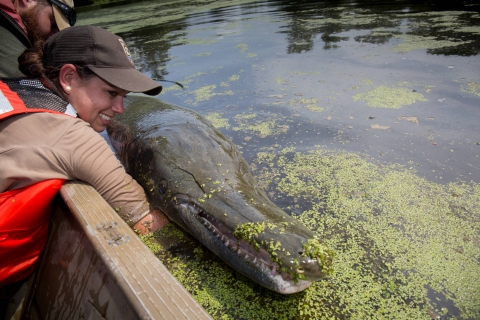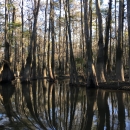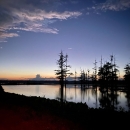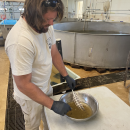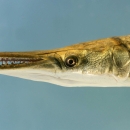The U.S. Fish and Wildlife Service is working to restore alligator gar (Atractosteus spatula) populations in the Lower Mississippi River Valley. Gar are not currently federally-listed as threatened or endangered. However, in some areas their populations have substantially decreased over the past 50 years prompting most states within their historic range to enact local protections.
Alligator gar are unique and important part of healthy ecosystems.
Alligator gar are a native species that provide balance to support a healthy stable ecosystem. They first evolved at least 100 million years ago, making them some of the most ancient vertebrate species in existence today. They are also one of the largest apex predators in the Mississippi River system where they commonly grow to be over 6 ft (1.8 m) long.
Learn more about Alligator gar
Habitat loss and over-harvesting have impacted some populations of alligator gar.
There are many reasons for declines in alligator gar populations, including habitat loss and over-harvesting. Historically alligator gar were considered a "trash or nuisance fish" and targeted for eradication but now these fascinating fish are becoming better understood and valued for their role in ecosystem balance. In some regions of the U.S. they are a highly-prized sportfish due to their size and dramatic appearance.
Our work takes a holistic approach to ensure safe and healthy populations of these ancient fish are around for future generations.
Assessing populations to better understand movement patterns, habitat use, and the status of the species.
Working with partners to conserve healthy habitat and restore altered habitat.
Boosting wild populations using hatchery raised fish.
Monitoring wild and restored populations.
Assessing populations to better understand movement patterns, habitat use, and the status of the species. (A.K.A. Counting Fish)
The Baton Rouge Fish and Wildlife Conservation Office conducts monitoring surveys to learn about habitat that is important to this vulnerable species at each stage of its life history. This information then helps to inform other conservation and management efforts. While biologists don’t completely understand abundance estimates for all alligator gar populations across their range, they are currently working to better understand population demographics of hatchery stocked fish. Counting fish is an important part of conservation. It helps us know which species are in trouble, which species are recovering, what efforts are helping, and where we need to do more. Without a strong monitoring and assessment program, conservation efforts can lack direction or effectiveness.
Working with partners to conserve healthy habitat and restore altered habitat.
Gar spawn (reproduce) in floodplains with connections to regular spring flooding from the river. Unfortunately for the alligator gar, and other floodplain species, flood control measures such as levees and dams have largely eliminated or fragmented their preferred spawning habitat in the Lower Mississippi River Valley. St. Catherine Creek National Wildlife Refuge is one of the few protected areas that still experience naturalistic flooding adjacent to the Mississippi River in southern Mississippi, and it is the only wildlife refuge in the country where alligator gar are fully protected. Because of this unique habitat and protection, the refuge is home to an important and healthy alligator gar population.
Boosting wild populations using hatchery raised fish.
In addition to studying the alligator gar population at the refuge, biologists also use a few wild adult fish from the refuge as brood or parent stock to help produce future generations of alligator gar. For the past twenty years national fish hatcheries like Pvt. John Allen National Fish Hatchery have been propagating alligator gar in the hatchery then stocking them into waterways within their historic range to help boost and restore wild populations. National fish hatcheries raise aquatic wildlife, like fish or mussels, to support conservation, help recover at-risk species, and to support recreational fishing.
There are many ways you can help migratory fish across America.
Learn more about fish migration and the National Fish Passage Program.
Visit a national wildlife refuge national wildlife refuge
A national wildlife refuge is typically a contiguous area of land and water managed by the U.S. Fish and Wildlife Service for the conservation and, where appropriate, restoration of fish, wildlife and plant resources and their habitats for the benefit of present and future generations of Americans.
Learn more about national wildlife refuge , national fish hatchery and other public lands. Find your nearest national wildlife refuge or national fish hatchery.Discover volunteer opportunities across America, including at nearby national wildlife refuges or hatcheries. Volunteer.gov is your go-to resource for volunteer openings on federal public lands.

